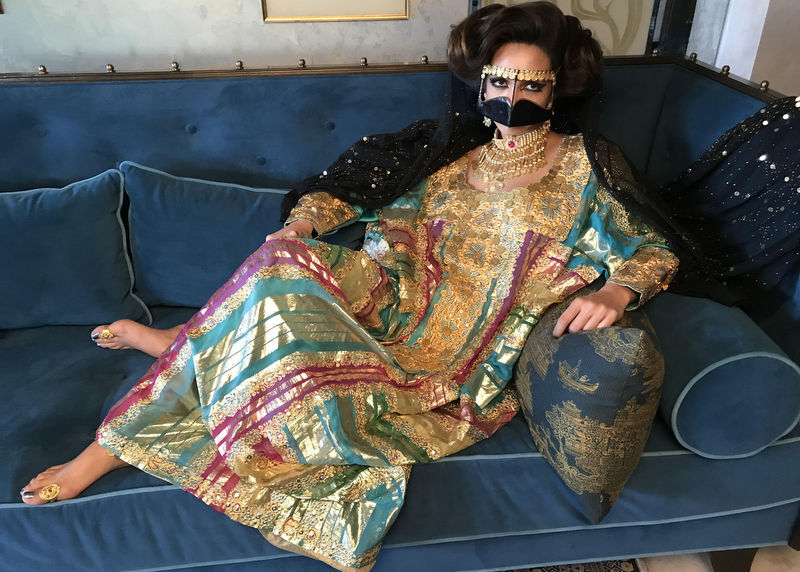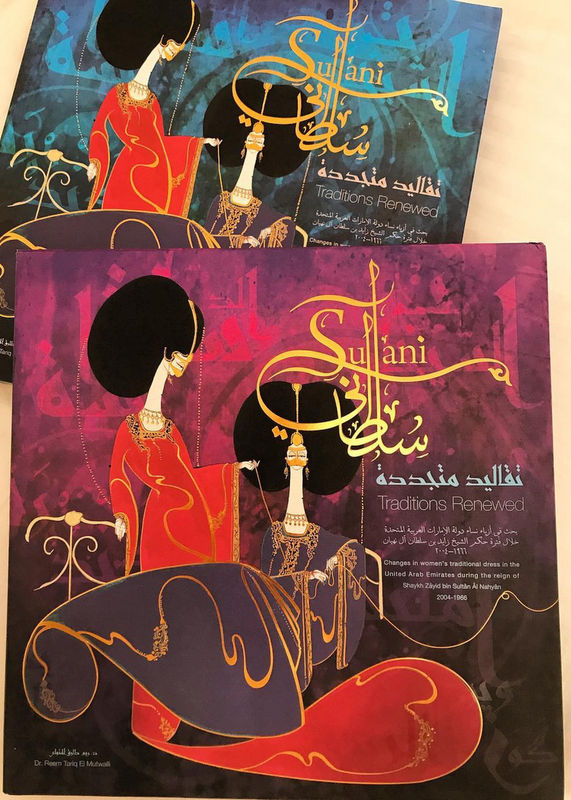




The Zay
Zay: (Arabic: costume, Pl. azyaā’), a set of clothes in a style typical of a particular country or historical period. Initiative is the brain
child of Dr Reem El Mutwalli. Understanding the cultural and historical
significance of the Zay
Zay: (Arabic: costume, Pl. azyaā’), a set of clothes in a style typical of a particular country or historical period. Initiative will be almost impossible without getting to
know her first.
“Iraqi by birth, Western in education and upbringing, Arab in spirit and Emirati in passion.” Reem came to the UAE in 1968 - the same year oil was discovered – as a young girl of five, when her father started working as the economic consultant to Sheikh Khalifa bin Zayed Al Nahyan, then the Crown Prince of the UAE.
Reem spent her childhood and
formative years surrounded by the women and children of the ruling family and
has many fond memories of the time. “I was exposed to the lifestyle in the UAE
back in the day, which was such a privilege.
Reem’s passion for textiles and
clothing started at a young age when she fell in love with the women’s dress in
the UAE. Reem’s passion has always been the woman’s life in this country and
she soon realised that she had a unique insight into an enclosed lifestyle that
were not being documented.

“When the UAE began to open to the
world through globalisation, it was important that this closed society be
recorded, registered and documented before it was gone. With all the changes
that were happening even the indigenous people of the area have forgotten
certain details of their past and heritage. It was important that we document
it. I find it a way to give back to a country that adopted me.”
After completing a degree in Interior
Design and Fine Art in the USA in 1984, Reem returned to the UAE to join the
newly founded Cultural Foundation in Abu Dhabi where she continued to work for
the next twenty years.
During this time, she was not only
in charge of exhibitions but started and built the Foundation’s own art
collection, advised on the art collections for members of the ruling family,
initiated art workshops and eventually became Deputy Head of the foundations
Arts and Exhibitions Department.

It was also during this time that
Reem conducted a full survey of all of Abu Dhabi’s forts as part of her master’s
degree in Islamic Art, architecture and archaeology. She also published the architectural
survey of the fort, Qasr Al Hosn, recording the historic, architectural and
social attributes of the building. The book is unique as it includes the first
published interviews with the members of the Al Nahyan family who last resided
in it.
Ṭariq: (Arabic; Synonym: tulle_bi_talli; talli; badla; khus_dozi ), series of small metal knots made on a woven net ground as embellishment. The term is commonly used in the Levant Arab region specifically in Lebanon.
El Mutwalli (2011). COLLECTIONReem’s position at the Cultural
Foundation became one of the cornerstones of her current role as guardian of
traditional Arab dress. “As I was representing the government, I felt that I
needed to dress in UAE traditional dress, in order to better represent the
position I was in. Over the years I
began collecting pieces from different friends and older relatives, members of the
ruling family commissioning pieces to be made, and slowly a collection began to
accumulate.”
Her precious collection of
traditional dress became the focus of Reem’s PhD in Islamic Art and
Archaeology. “I began to look at my collection more academically. Whatever I
had amassed needed to be organised, catalogued, properly chronicled. Then I
could see where I needed to fill holes in the collection, looking for specific
pieces that I knew needed to be added to make it a proper historical
collection.”

Ṭariq: (Arabic; Synonym: tulle_bi_talli; talli; badla; khus_dozi ), series of small metal knots made on a woven net ground as embellishment. The term is commonly used in the Levant Arab region specifically in Lebanon.
El Mutwalli (2011). CollectionReem had to
learn how the dresses were made, their history, the construction, the
techniques used, the materials, how they were measured by hand, how they
related each body part to the design, and how each was tailored by hand or
machinery.
The
collection currently consists of 180-pieces, with some of the dresses dating
back to the 1950s, from the pre-oil era all the way through to today. Key
pieces include two dresses, one embroidered with gold coins and one with silver.
“These pieces are very valuable, and they came from members of the ruling
family. This is how the women carried their wealth, keeping their bank account
close to their heart, because they lived a nomadic life, but only people from
the wealthier echelons of society would be able to commission something like
this. The dress would probably be worn a few times before a daughter or sister
would borrow it or it would be deconstructed and reworked into something new.”

Ṭariq: (Arabic; Synonym: tulle_bi_talli; talli; badla; khus_dozi ), series of small metal knots made on a woven net ground as embellishment. The term is commonly used in the Levant Arab region specifically in Lebanon.
El Mutwalli (2011). BooksReem’s collection Ṭariq: (Arabic; Synonym: tulle_bi_talli; talli; badla; khus_dozi ), series of small metal knots made on a woven net ground as embellishment. The term is commonly used in the Levant Arab region specifically in Lebanon.
and PhD thesis culminated in the publication of the Sultani
Sulṭānī: (Arabic: sultān: king). In the UAE the term denotes to silk satin fabric in multiple vertical striped colours, commonly used for tunics (kanadir) and underpants (sarāwīl). Also refers to book: Sultani, Traditions Renewed, Changes in women’s traditional dress In the United Arab Emirates during the reign of the late Shaykh Zāyid Bin Sultan āl Nahyān, 1966-2004, By Dr. Reem Tariq
in its own right. This 600+ two-volume tome contains detail background and
research on the geographical, political and cultural influences on UAE dress,
detail information in the construction of garments, the textiles and
embellishments, as well as in-depth analysis of the different items of
traditional dress including headdress, body covers, underwear, and footwear. It
also features unique and never before seen images of women in UAE national
dress through the years.
The Sultani
Sulṭānī: (Arabic: sultān: king). In the UAE the term denotes to silk satin fabric in multiple vertical striped colours, commonly used for tunics (kanadir) and underpants (sarāwīl). Also refers to book: Sultani, Traditions Renewed, Changes in women’s traditional dress In the United Arab Emirates during the reign of the late Shaykh Zāyid Bin Sultan āl Nahyān, 1966-2004, By Dr. Reem Tariq
Ṭariq: (Arabic; Synonym: tulle_bi_talli; talli; badla; khus_dozi ), series of small metal knots made on a woven net ground as embellishment. The term is commonly used in the Levant Arab region specifically in Lebanon.
Collection, as Reem’s dress collection became known, now forms the foundation
on which The Zay
Zay: (Arabic: costume, Pl. azyaā’), a set of clothes in a style typical of a particular country or historical period. Initiative will be built. By sharing her knowledge and
precious collections, and by using her distinct design style,
exhibition-planning experience, and access to important role players, Dr Reem
El Mutwalli is building a legacy. Not just for herself but also for the wider
Arab region, and ultimately, the world.